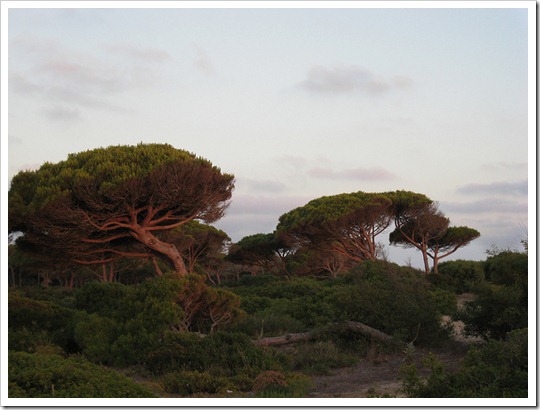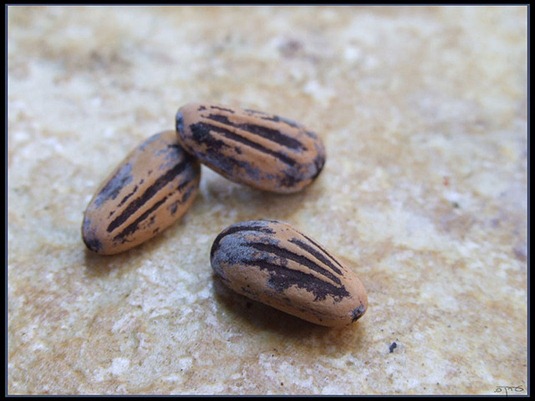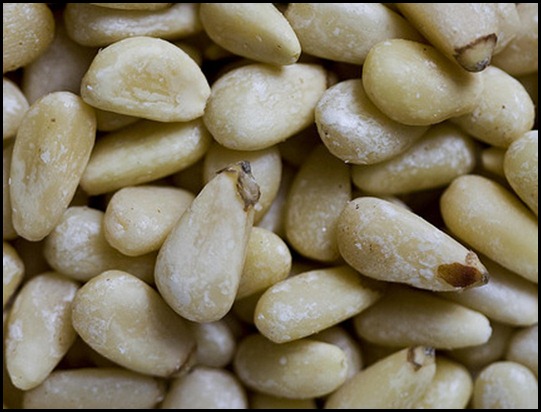The Pinoli Thieves Posted by Geoff on Feb 11, 2015 in News
Pinoli, essential ingredient of many Italian culinary delights, such as the classic pesto alla Genovese, are becoming so valuable, at up to 100 euros a kilo, that they are being targeted by thieves for resale on he black market.
What Are Pinoli?
 |
| Pino Pinea (The Stone, or Umbrella Pine). Photo (CC) by Matt Westgate |
Pinoli, Pine nuts, as the name suggests, are nuts that come from pine trees, bet you didn’t know that did you? In Italy, the particular tree in question is the classic Mediterranean Pino Pinea, commonly known as the Stone or Umbrella Pine. The umbrella pine produces a massive cone which, if you happen to be passing beneath the tree at the wrong moment, can give you a nasty bump on the head.
 |
| Pinoli as they appear when they fall from their cone. Photo (CC) by Eran Finkle |
The first time that I appreciated exactly why pinoli are so expensive was when Serena and I went to stay with some relatives of hers in Albissola on the Ligurian coast one summer. The steep rocky hillsides around the town are covered with macchia mediterranea, ancient olive groves, and umbrella pines. One day, as we toiled our way up a trail between the olive groves, I spotted some strange dark brown velvety nuts at my feet. “Pinoli!”, exclaimed Serena, stooping to gather them up in the palms of her hands, which were immediately powdered by the deep brown dusty coat that envelopes them.
 |
| Pinoli freed from their shells. Photo (CC) by babbagecabbage |
Have you ever used a pine cone as a weather indicator? If you have, you’ll know that the cone closes in humid conditions, and opens itself up when the weather it hot and dry. Under favourable conditions, the tiny hinges of the cone prize open each little ‘trap door’ to reveal a small velvety nut, which, released from it’s storage pod, falls to the earth below. This is the seed of the pine tree, and for at least 6,000 years it has been cultivated and gathered as a tasty, nutritious foodstuff.
To get to the edible part, however, you have to break open that hard brown shell, and extract the tiny fruit within. After half an hour with a hammer and a large flat stone on the patio, the handful of pine nuts gathered by Serena had become a mere thimbleful of fruit. We had bits of broken nut everywhere, and sore fingers covered in the staining brown powder. “So that’s why these little buggers are so expensive” was my conclusion.
Contraband Pine Nuts … Really?
But are these little nuts seriously the stuff of thievery and intrigue, of mysterious packages changing hands in seedy alleyways? Well people are people, and anything with an elevated value, however banal, can become a target for the less scrupulous, as is attested by the following reports:
28 gennaio 2015: Trenta buste di pinoli, valore totale 200 euro: li aveva un 23enne romeno arrestato per furto dai carabinieri di Perugia. Fuggiti due complici. I tre potrebbero far parte di un’organizzazione dedita ai furti di pinoli, da rivendere al mercato nero.
28th of January 2015: Thirty bags of pinoli, total value 200 Euro: A 23 year old Romanian had them when he was arrested for robbery by the Carabinieri of Perugia. Two accomplices escaped. The three could be part of an organisation dedicated to the theft of pine nuts, to be sold on the black market
9 dicembre 2014: Pozzuoli: arrestato un 46enne dipendente di un megastore all’ingrosso dopo aver rubato 4 chili di pinoli e 3 kg di mandorle per un valore di circa 350 euro.
9th of December 2014: a 46 year old employee at a wholesale mega-store is arrested after having stolen 4 kilos of pine nuts and 3 kilos of almonds, valued at around 350 Euro.
14 novembre 2014: Furto aggravato è l’accusa contestata a quattro romeni arrestati dopo avere rubato da un negozio circa 10 chili di pinoli. Nel bagagliaio erano nascoste cento confezioni di pinoli e altra merce, per un valore complessivo di mille euro.
14th of November: Aggravated theft is the accusation against four Romanians arrested after having stolen about 10 kilos of pinoli from a shop. 100 packs of pinoli and other merchandise were hidden in the boot of the car, with a total value of 1,000 Euro.
19 settembre 2014: A Vado Ligure (Sv) arrestato dai carabinieri un dipendente della Noberasco (il principale grossista italiano di pinoli, ndr): in un borsone trovati 17 chili di pinoli. Da otto mesi la direzione dell’azienda si era accorta di continui ammanchi di merce dal deposito per un danno complessivo di almeno 25 mila euro. Tre giorni prima una 19enne in un supermercato del Ponente genovese aveva prelevato 415 euro di pinoli.
19th of September 2014: At Vado Ligure (Savona) an employee of Noberasco (the main Italian pinoli wholesaler) was arrested by the Carabinieri: 17 kilos of pinoli were found in a bag. For 8 months the management of the firm had been aware of merchandise going missing from the warehouse, amounting to 25 thousand Euro lost. Three days beforehand, a 19 year old in a supermarket at Ponente Genovese had ‘withdrawn’ 415 Euro worth of pinoli.
21 agosto 2014: Tre romeni ieri sono stati sorpresi a rubare una quarantina di confezioni di pinoli all’Ipercoop del Centroborgo, alla periferia di Bologna, per circa 350 euro. Nella stessa Ipercoop il 29 agosto fermati due romeni per il furto di bustine di zafferano per un valore di 500 euro.
21st of August 2014: Three Romanians were caught by surprise whilst they were stealing about forty packets of pinoli from the Ipercoop (supermarket) at Centroborgo, in the suburbs of Bologna, worth about 350 Euro. In the same Ipercoop on the 29th of august two Romanians were arrested for the theft of packs of saffron worth 500 Euro
Are you a pine nut fan? Have you ever tried gathering and shelling them by hand? Well, maybe that’s something new to try on your next visit to Italy. I guarantee that you’ll never look at a packet of pinoli the same way again!
To find out why the value of pinoli has soared in the last few years you might like to read this article (in Italian).

Build vocabulary, practice pronunciation, and more with Transparent Language Online. Available anytime, anywhere, on any device.




Comments:
Mike:
Geoff & Serena
Come sempre, grazie per le ottime email.
Are you aware that many of your emails, like this one The Pinoli Thieves, contain a folder of (irrelevant?) flickr pictures as attachments which sometimes just show up as file name and sometimes some of the pics appear in part at top of email? Recent emails which are still in my inbox, which DIDN’T have this are Nevicata and Tree of Life 2. Others did. It may be that when you access flickr for a picture in your email, you get the unwanted “attachment” as well. Non lo so .. but if you send yourself the emails as well you should see what I, and everyone else (?) is seeing.
Saluti
Mike
Geoff:
@Mike Salve Mike, our articles are published as blogs on the internet. We have absolutely no idea about the e-mail format. We write our articles for Transparent Language, and upload them to the Transparent Italian Blog page, and for us, that’s the end of the story. I’ll have to contact our line manager to find out about the e-mail format.
However, if you have an active internet connection I suggest that you read the blogs in their original format here: https://blogs.transparent.com/italian/
Here, for example, is the original article about the pinoli thieves: https://blogs.transparent.com/italian/the-pinoli-thieves/
As you can see, it contains 3 images taken from flickr for copyright purposes. We have to be careful about copyright, so if we don’t have a particular image which we need for an article we often search through the Creative Commons images on flickr, which are copyright free.
Let me know how you get on with the transparent Italian web page. In the mean time I’ll forward your mail to our manager.
Saluti da Geoff